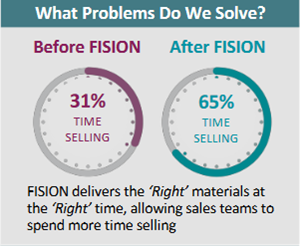How FISION Improves Frontline Efficiency and Engagement
It has been coded into human nature to pay more attention when it is personalized and familiar. Based on a corresponding social value signal in neural circuits of reward, scientists have found that familiarity creates favorable feelings in our brains. This inherited instinct is the primary driver for the growth of the marketing and sales automation market. As a result, today, countless software products exist to automate marketing and manage customer relationships, but in between those two activities, many large brands still struggle to localize their marketing content and maintain brand consistency. To understand the reason behind this gap and learn more about how to bridge it through technology, we reached out to Mike Brown, the founder and CEO of FISION, a provider of cloud-based digital asset management and sales enablement technology.
Based on a corresponding social value signal in neural circuits of reward, scientists have found that familiarity creates favorable feelings in our brains. This inherited instinct is the primary driver for the growth of the marketing and sales automation market. As a result, today, countless software products exist to automate marketing and manage customer relationships, but in between those two activities, many large brands still struggle to localize their marketing content and maintain brand consistency. To understand the reason behind this gap and learn more about how to bridge it through technology, we reached out to Mike Brown, the founder and CEO of FISION, a provider of cloud-based digital asset management and sales enablement technology.
How was FISION Born?
First things first, we inquired with Brown on his background and how he came up with FISION. Brown’s background is surprisingly not in technology. In fact, prior to launching FISION Corporation back in 2011, he was the senior vice president of sales, operations, and marketing at LifeTime Fitness. The reason why he got into the technology side is that the organization he was working for was having a really difficult time controlling brand, brand messaging, and legal compliance around that brand messaging across over 70 distributed health clubs. The organization needed a technology that could provide them with an easy user interface to connect the front line sales, operations, and centrally controlled marketing teams altogether. After an expansive search, he faced the fact that there is no technology out there to support these dynamics with an ease of use. As a result, he decided to take the matter into his own hands and hatched to the idea of building FISION.
FISION is a Patented, cloud-based marketing technology that simplifies brand distribution and sales enablement across large distributed enterprises, that drives top line revenue and bottom line profit. While he was developing the platform, he said that he focused on “supporting a brand while supporting legal compliance with all the various constituencies that have various different business needs, business rules and processes and unique local concerns.” According to Brown, “FISION designed the platform primarily for the front line team and made it very simple, very easy, and actually enjoyable to use.”
The Evolution of Sales Enablement
During the interview, to emphasize how important it is for sales forces to have an easy and efficient technology in place, Brown took us back in time when sales force applications and automation were much different than how they are today: “I remember the times before SalesForce, there was Siebel as a CRM and it was very difficult and terrible to use. My team would not use it. Then, SalesForce came along saying that they were going to make this process easier to use. Also, they said that they would make it a system by which sales leadership can hold accountable for their sales team as the original martech wasn’t designed for the engagement between the salesperson and the potential customer, yet it was designed to track and hold accountable the Sales Teams.”
We couldn’t agree more that the sales force automation technology has recently changed but initially, the common use of that technology was programmatically prescribing rigid sales processes wrapped around basic contact and account management. The solutions in the market were designed around the needs of managers and executives. Therefore, over the years, they became simply obsolete to effectively support the needs of sellers and frontline customer engagement professionals to keep up with rapidly changing buyer behaviors. Those solutions were also making salespeople less productive due to having been designed around the needs of managers and executives so salespeople were spending a great deal of time on the preparation of those forecasts and activity reports and less time on nurturing prospects and customers. Today, as we all know, to be able to survive, businesses should put their customers at the center of their technology platform. Thanks to the altering needs of both salespeople and customers alongside evolving technology advancement, the vendors finally shifted their focus from a sales management tool to a seller empowerment channel.
Since the old-fashioned solutions were all about arbitrary metrics to gauge sales performance were focused on the quantity of data such as the number of calls made, meetings scheduled, and contacts created, the quality of engagement was ignored – which leads us to Brown’s great points on how new technology enables sales and marketing teams to respond to buyers’ ever-increasing demand for personalized interactions with brands. “Marketers and salespeople started to ask themselves these questions: How do I have a relevant conversation with this prospect and give them exactly the information they need, exactly when they need it? How do I enhance my probability of success on the sales call?’ And, that's where FISION comes in. Every single person that interacts with your brand has a very specific reason to do so and your sales team or your distributed frontline employees need to have the ability to communicate with them in that very specific unique way. So while we were architecting FISION, I asked why can't we create that same exact concept? Then, we've engineered and architected FISION to be able to create that localization between two peer groups and to vocalize that message in a simplistic way.”
FISION wanted to go beyond being a typical sales automation platform thus this past May, the company acquired Minneapolis-based Volerro Corporation, a provider of technology that simplifies how enterprise teams create, refine and distribute content. Brown said that they are “in the midst of integrating Volerro into the front end of FISION platform.” He also gave us some tidbits about what to expect from the company in the upcoming months: “Once completed, the collaboration between central marketing and frontline professionals will be even more direct and immediate.” Their mission is to bridge the gap between the field & sales marketing teams and the central marketing teams.
More on the Partnership with Marketo and Oracle
Knowing the company has a channel partnership with very important technology providers  including Marketo, Oracle/Eloqua, Iris, RAZR, and Premier Logic, we were eager to learn more on their partner engagement. “The first interactions with Marketo and Eloqua have begun through our CRO Jason Mitzo as he was a technology sales leader at Oracle,” stated Brown and told the story of how the partnerships have developed: “Those initial conversations led Oracle and Marketo to approach FISION as there was a unique opportunity that we all could tap into. They said to us that they’ve got great customers and have done a great job generating marketing qualified leads but they were, on the other hand, struggling with managing, controlling, and distributing digital content. Then, they asked us if we would partner with them on those sales processes.” Brown claims that their technology complements Marketing Automation and Customer Relationship Management (CRM) platforms as it extends them to more effectively empower distributed sales teams and local marketers.
including Marketo, Oracle/Eloqua, Iris, RAZR, and Premier Logic, we were eager to learn more on their partner engagement. “The first interactions with Marketo and Eloqua have begun through our CRO Jason Mitzo as he was a technology sales leader at Oracle,” stated Brown and told the story of how the partnerships have developed: “Those initial conversations led Oracle and Marketo to approach FISION as there was a unique opportunity that we all could tap into. They said to us that they’ve got great customers and have done a great job generating marketing qualified leads but they were, on the other hand, struggling with managing, controlling, and distributing digital content. Then, they asked us if we would partner with them on those sales processes.” Brown claims that their technology complements Marketing Automation and Customer Relationship Management (CRM) platforms as it extends them to more effectively empower distributed sales teams and local marketers.
"Oracle Eloqua is always looking to foster relationships with best-in-class partners that help us deliver a diverse portfolio of innovative marketing technologies. By working collaboratively with FISION’s marketing & sales enablement platform, we ensure that we’re able to deliver the best modern marketing experience possible to our clients and partners. It’s created a differentiation for us in the marketplace and helps our customers drive new levels of efficiency and business growth,” said the director of customer experience at Oracle in a statement.
When marketing automation platforms are being discussed, it often turns on the arguments  about how those automation platforms will take over humans’ jobs to reduce labor costs. While it is one of the advantages or disadvantages (depending on where you are looking at the equation), the majority of the benefits actually come not from reducing labor costs, but from raising productivity through fewer errors, higher and faster output, and increased quality and safety. FISION, for instance, states that the average sales rep spends 31% of their time selling and nearly 34% of their time looking for the right materials. And the vendor claims that they put that time back in salespeople as the platform provides access to the “Right” materials at the “Right” time, enabling sales teams to spend more time selling — all while maintaining brand & legal compliance.
about how those automation platforms will take over humans’ jobs to reduce labor costs. While it is one of the advantages or disadvantages (depending on where you are looking at the equation), the majority of the benefits actually come not from reducing labor costs, but from raising productivity through fewer errors, higher and faster output, and increased quality and safety. FISION, for instance, states that the average sales rep spends 31% of their time selling and nearly 34% of their time looking for the right materials. And the vendor claims that they put that time back in salespeople as the platform provides access to the “Right” materials at the “Right” time, enabling sales teams to spend more time selling — all while maintaining brand & legal compliance.
We are seeing a shift away from quantity, toward quality. Within the next five years, we  anticipate investment in ad impressions going down. Instead, marketing budgets will go towards brand experiences, CX and in-store experiences and knowledge of sales agents – the things that will help demonstrate brand promise,” said Shar VanBoskirk, principal analyst at Forrester, in a statement. “Many companies now are wasting impressions, which can annoy customers. It is important to determine user needs and tailor content appropriately. In addition, the structure of marketing and digital teams will shift as agencies take a more holistic and integrated approach to planning.”
anticipate investment in ad impressions going down. Instead, marketing budgets will go towards brand experiences, CX and in-store experiences and knowledge of sales agents – the things that will help demonstrate brand promise,” said Shar VanBoskirk, principal analyst at Forrester, in a statement. “Many companies now are wasting impressions, which can annoy customers. It is important to determine user needs and tailor content appropriately. In addition, the structure of marketing and digital teams will shift as agencies take a more holistic and integrated approach to planning.”
Circling back to FISION, in late spring 2016, the company shifted their sales focus from the SMB market to the enterprise market and have secured large organizations including SAP, Otis, Ameriprise, Postnet, Capella University, Shopko, and much more. The acquisition of Volerro also added a new customer base to its portfolio which significantly advances and strengthens FISION’s financial services vertical and opens a new vertical with retail, according to the company.
Before You Go
Sales reps used to be viewed as a valuable source of information but today it doesn’t apply to the business world anymore as the success of a sales rep mostly depends on how meaningful and relevant interactions they can provide to their prospects and customers. To do so, they have to be armed with technology that injects intelligence to lead qualification and forecasting processes. Fortunately, marketing and sales technology is one of the top areas for the investment in AI technologies. Soon enough, it will be a norm for all businesses to truly wrap their products and services around the customer journey.

Venus Tamturk
Venus is the Media Reporter for CMS-Connected, with one of her tasks to write thorough articles by creating the most up-to-date and engaging content using B2B digital marketing. She enjoys increasing brand equity and conversion through the strategic use of social media channels and integrated media marketing plans.

Laura Myers
A digital business, marketing and social media enthusiast, Laura thrives on asking unique, insightful questions to ignite conversation. At an event or remotely, she enjoys any opportunity to connect with like-minded people in the industry.